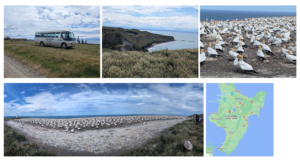I wonder when it happened that I became an old person – or at least, a person who enjoys “old people” activities. I’ll admit it: Of late, I’ve come to appreciate the pleasures of sitting on a comfy couch, sipping hot tea and solving crossword puzzles. I’ve come to admire a well-planned garden. And apparently, I’ve also become an enthusiastic bird watcher.
Not that I wasn’t a wee bit skeptical when my wife, Donica, suggested we book a gannet safari while touring the North Island of New Zealand.
“What’s a gannet?”
“It’s a cool seabird.”
What I said: “And you want to do a 3-hour gannet-watching tour? It sounds…fun.”
What I thought: “Really? A half-day of bird watching? What a snooze! The things I do for love!”

Well, as it turned out, gannets are no ordinary seabirds, and our tour was anything but boring. In fact, believe it or not, it was one of the highlights of our New Zealand trip. To start, gannets are really beautiful. With their white bodies and orange necks, gannets are about twice the size of seagulls. If you can envision a pair of lovely orange and white birds, roosting on a stark, grassy cliff overlooking the sparkling South Pacific Ocean, perhaps you can now imagine a gannet colony with thousands of birds, all crowded into one breeding ground, busily dive bombing in and out, feathering their nests and tending to their fluffy-white chicks. This particular site features four colonies, hosting an estimated 20,000 birds! It’s an awesome sight!
According to our guide, adult gannets arrive at Cape Kidnappers every year around July to begin courtship and nest building. Most gannets don’t breed until they are at least 4 or 5 years old. But when they do mate, it is often for a lifetime, anywhere from 20 to 33 years. Paired gannets rub their beaks and necks together, preen head feathers, bow, and call to each other. Time and again, we delight to observe paired love birds rubbing necks, nudging each other adoringly, and in general exhibiting unembarrassed PDA (public displays of affection) with great abandon, especially when a partner returns home to the nest. “Hi Honey, I’m home.” Nuzzle nuzzle.
Strange fact: When the chicks arrive at flying age, they depart for an 8-day trip to the Great Barrier Reef in Australia! Alas, 70-80% of these birds will die over the next 2-3 years before having a chance to return to their roost in Cape Kidnappers. Not a great flight record.
All in all, I’d say, if you happen t9 find your way to this part of the world, I would definitely recommend a gannet safari. The scenery is spectacular and the birds are amazing. Apparently bird watching isn’t just for old people!
(We run a load of assumptions around aging, with the biases running both ways. “You’re too old to go sky diving.” “You’re too young to be knitting.” These assumptions are all nonsense. Who’s to say you can’t be an 80-year-old with a young spirit, or a 25-year-old “old soul.” I say, throw aside the suppositions and presumptions and just be yourself. Physical age means nothing. You be you.)
